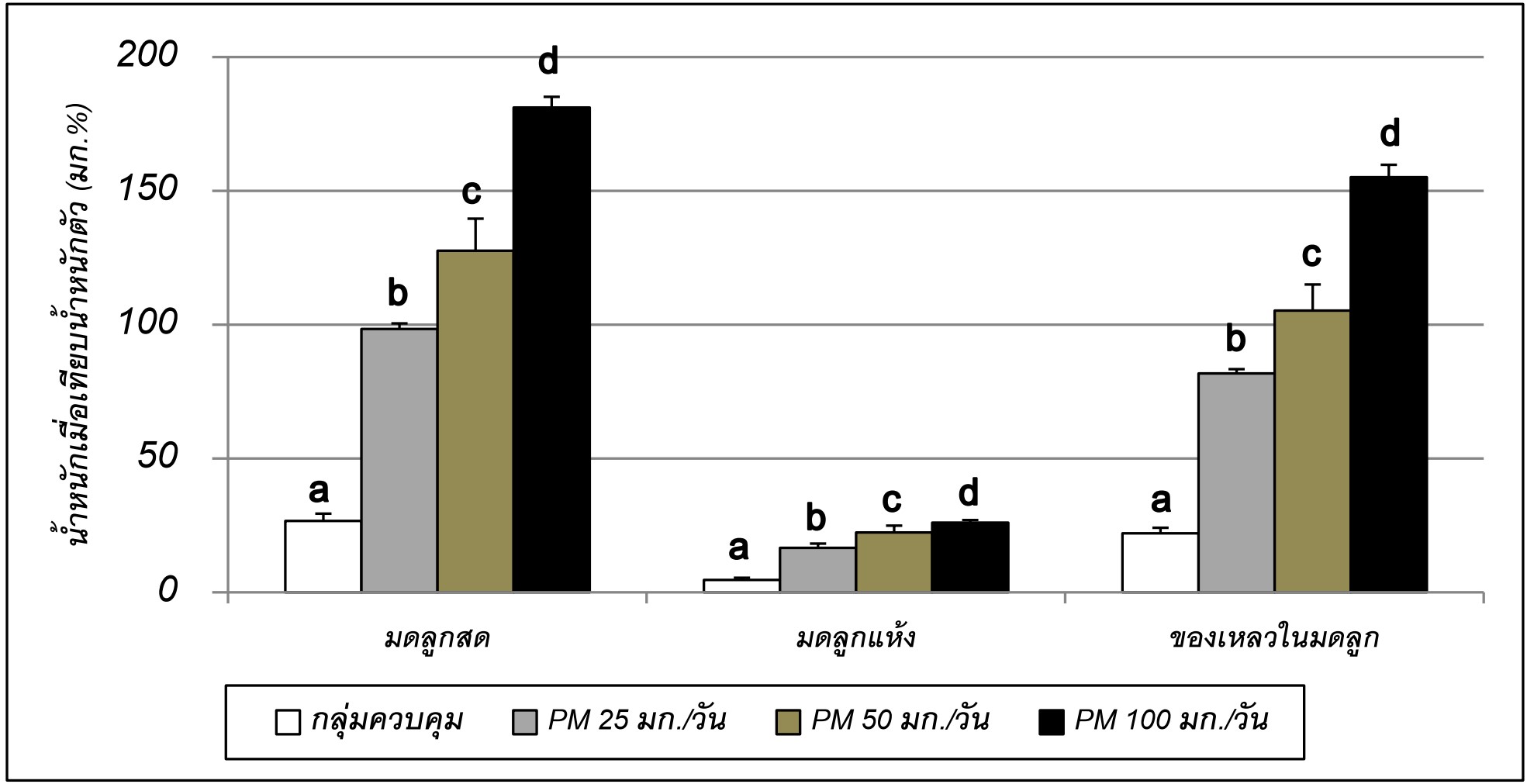Estrogenic and Antifertility Effects of Pueraria mirifica Collected for 30 Years in Rats
Main Article Content
Abstract
The objective of this study was to investigate the estrogenic and antifertility effects of Pueraria mirifica tuber powder collected for 30 years since 1987 (PM) in female rats. There are 2 experiments in this study. The first experiment was the investigation of the estrogenic effects of PM in ovariectomized mature rats by oral feeding with 3 different dosages of PM (25, 50 and 100 mg. /rat/day) for 4 consecutive days compared with the control group (7 rats/group). Uterine wet and dried weight and liquid content were used as the indicators of the estrogenic potency of PM. The second experiment was the investigation on the antifertility effects of PM in mature female rats. In this experiment, the female rats were caged with male at the ratio of 2 females : 1 male ( 10 cages/ group) . Oral feeding of the highest dosage of PM ( from the first experiment) to only the female rats for 14 consecutive days compared with the control group. After 14-day treatment of PM to the females, male rats from both groups were removed and the female rats were left and stayed in each cage for another 21 days.
During 21-day of observation : number of pregnant and parturient rats, number of live fetuses delivered were noted. After that, all of the female rats in each group were sacrificed and note that the rats became pregnant or not. If the rats were pregnant, number of embryos IN UTERO were counted and noted. The results were found that PM collected for 30 years still pronounced the estrogenic activities in bilaterally ovariectomized rats as indicated from the uterine wet and dried weight and liquid content were significantly higher than the control group (p<0. 01) . The studies on the antifertility effects of 30th yr. PM in mature female rats revealed that 30th yr. PM was still show contraceptive effect. In this group, rats could pregnant 40 %.
Article Details
References
กรมพัฒนาการแพทย์แผนไทยและการแพทย์ทางเลือก. 2551. คู่มือการใช้สมุนไพร ไทย-จีน. องค์การ
ทหารผ่านศึกในพระบรมราชูปถัมภ์, กรุงเทพฯ.
กิตติ ลี้สยาม. 2556. ความรู้ทั่วไปเกี่ยวกับสมุนไพร. แหล่งข้อมูล: http://www.stou.ac.th
/Schools/Shs/booklet/book56_1/thai.htm. สืบค้นเมื่อ 16 มิถุนายน 2559.
ยุทธนา สมิตะสิริ. 2530. การตรวจสอบฤทธิ์เอสโตรเจนและฤทธิ์คุมกำเนิดของกวาวเครือขาวปีที่เก็บใน
หนูขาว. รายงานการวิจัยหน่วยวิจัยกวาวเครือ. มหาวิทยาลัยเชียงใหม่, เชียงใหม่.
_______. 2531. การตรวจสอบฤทธิ์เอสโตรเจนและฤทธิ์คุมกำเนิดของกวาวเครือขาวที่เก็บไว้เป็นเวลา
ปี ในหนูขาว.รายงานการวิจัยหน่วยวิจัยกวาวเครือ. มหาวิทยาลัยเชียงใหม่, เชียงใหม่.
_______. 2546. การถ่ายทอดเทคโนโลยีสมุนไพรกวาวเครือขาวสู่ชุมชนจังหวัดเชียงราย. สำนักวิชา
วิทยาศาสตร์มหาวิทยาลัยแม่ฟ้าหลวง, เชียงราย.
_______ . 2547. สรุปข้อมูลการศึกษากวาวเครือ. น. 44-49. ใน: ยุพิน เข็มมุกด์ (บรรณาธิการ),
ตำรายาหัวกวาวเครือของหลวงอนุสารสุนทร. ธาราทองการพิมพ์, เชียงใหม่.
ยุทธนา สมิตะสิริ และ วัชระ วงค์วิริยะ. 2540. การตรวจสอบฤทธิ์เอสโตรเจนและฤทธิ์คุมกำเนิดของ
กวาวเครือขาวที่เก็บไว้เป็นเวลา 10 ปีในหนูขาว. รายงานวิจัย ห้องปฏิบัติการวิจัยกวาวเครือ
สำนักวิชาวิทยาศาสตร์ มหาวิทยาลัยเทคโนโลยีสุรนารี, นครราชสีมา.
ยุทธนา สมิตะสิริ และ สมศรี วงค์เรือน. 2545. การตรวจสอบฤทธิ์เอสโตรเจนและฤทธิ์คุมกำเนิดของ
กวาวเครือขาวที่เก็บไว้เป็นเวลา 15 ปีในหนูขาว. รายงานวิจัยห้องปฏิบัติการวิจัยกวาวเครือ
มหาวิทยาลัยแม่ฟ้าหลวง, เชียงราย.
วสันต์ มะโนเรือง. 2557. ฤทธิ์คล้ายเอสโตรเจนและฤทธิ์คุมกำเนิดของกวาวเครือขาวที่เก็บไว้เป็นเวลา
ปี ในหนูขาว. วารสารวิจัย มสด สาขาวิทยาศาสตร์และเทคโนโลยี. 7(3): 61-73.
วสันต์ มะโนเรือง และ ยุทธนา สมิตะสิริ. 2535. การตรวจสอบฤทธิ์เอสโตรเจนและฤทธิ์คุมกำเนิดของ
กวาวเครือขาวที่เก็บไว้เป็นเวลา 5 ปีในหนูขาว. น. 224. ใน: การประชุมทางวิชาการครั้งที่ 10
เทคนิคของวิธีทางวิทยาศาสตร์ชีวภาพ. ศูนย์ปฏิบัติการวิจัยและเรือนปลูกพืชทดลอง
สถาบันวิจัยและพัฒนาแห่งมหาวิทยาลัยเกษตรศาสตร์ กำแพงแสน, นครปฐม.
วิชัย เชิดชีวศาสตร์. 2552. นวัตกรรมสมุนไพรกวาวเครือขาว. สำนักพิมพ์แห่งจุฬาลงกรณ์มหาวิทยาลัย,
กรุงเทพฯ.
หลวงอนุสารสุนทร. 2547. สรุปข้อมูลการศึกษากวาวเครือ. น. 44-49. ใน: ยุพิน เข็มมุกด์
(บรรณาธิการ), ตำรายาหัวกวาวเครือของหลวงอนุสารสุนทร. ธาราทองการพิมพ์, เชียงใหม่.
Chansakaow, S., Ishikawa,T., Seki, H., Sekine, K., Okada,M., and Chaichantipyuth, C. 2000.
Identification of deoxymiroestrol as the actual rejuvenating principle of
"Kwao Keur", Pueraria mirifica. The known miroestrol may be an artifact.
Journal of Natural Products. 63(2): 173-175.
Ingham, J.L., Tahara, S. and Dziedzic, S.Z. 1986. A chemical investigation of
Pueraria mirifica. Zeitschrift für Naturforschung. 41c: 403-408.
_______ . 1989. Minor isoflavone from root of Pueraria mirifica. Zeitschrift für
Naturforschung. 44: 724-726.
Jones, H.E.H. and Pope, G.S. 1961. A method for the isolation of miroestrol from
Pueraria mirifica. Journal of Endocrinology. 22: 303–312.
Malaivijitnond, S., Chansri, K., Kijkuokul, P., Urasopon, N., and Cherdshewasart, W. 2006.
Using vaginal cytology to assess the estrogenic activity of phytoestrogen-rich
herb. Journal of Ethnopharmacology. 107(3): 354-360.
Malaivijitnond, S., Kiatthaipipat, P., Cherdshewasart, W., Watanabe, G., and Taya, K.
Different effects of Pueraria mirifica, a herb containing phytoestrogens,
on LH and FSH secretion in gonadectomized female and male rats. Journal of
Pharmacological Sciences. 96: 428-435.
Manoruang, W., and Smitasiri, Y. 2007. Estrogenic and antifertility effects of
Pueraria mirifica collected for 20 years in mice. In: The 3rd Global Summit
on Medicinal and Aromatic Plants. Chiang Mai University and International
Acadamic Services Center Chiang Mai, & Century Foundation Bangalore India,
Chiang Mai.
Matsumura, A., Ghosh, A., Pope, G.S., and Darbre, P.D. 2005. Comparative study of
oestrogenic properties of eight phytoestrogens in MCF7 human breast
cancer cells. Journal of Steroid Biochemistry and Molecular Biology. 94:
–443.
Phansawan, B., Sang-Arun, J., Smitasiri, Y., Puangbangpho. S. and Suttajit, M. 2003.
Antioxidative Activity of Kwao Keur. In: 3rd World Congress on Medicinal and
Aromatic Plants for Human. Lotus Hotel Pang Suan Kaew Hotel, Chiang Mai.


